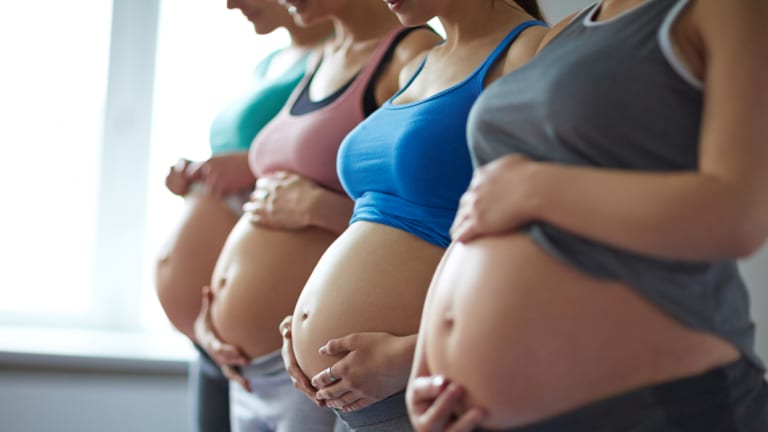
I did everything I could to stay fit while I was pregnant. I ran a steep lighthouse route until well into my sixth month and, right up until the week I gave birth, I inverted and balanced and breathed my way through power yoga classes.
It seemed like a no-brainer. Fitness improves birthing outcomes and the benefits extend, for both mother and baby, well beyond the birth. It’s also possible that a tiny part of me wanted to prove that I wasn’t somehow ‘weakened’ by pregnancy; I could still do whatever I wanted.
Fitness during pregnancy is important, but is there a threshold to the benefits? No, says a new study. Credit:Shutterstock
I was less in control than I liked to believe.
Births often don’t go according to plan, but I couldn’t have prepared for just how far off plan my daughter’s birth went. After a complication-free pregnancy and hoping for a natural, drug-free birth, I booked in to the local midwife-led birthing clinic. I’d done the breathing and the visualisation and when labour began, at the end of last year, I felt excited and ready. Then the contractions thickened into relentless, reliefless waves that crashed over me and held me under hour after hour even though I wasn’t "progressing".
Thirty hours later, silent with screaming pain, I transferred 45 minutes to the nearest hospital and bub, obstructed and with her heart beat going on the blink, was delivered via an emergency caesarean, aka all the drugs.
Exhausted, traumatised and thankful – as one midwife pointed out – that I didn’t live in a third world country, I wondered how it went so wrong. There were no immediate answers, but the more I spoke with friends, the more anecdotes I heard about yoga teacher and fitness instructor mums having particularly complicated births.
One dancer friend said, like me, she wondered if she had pushed too hard ‘to prove a point’ to herself and, now pregnant for the second time, was focusing less on strength and keeping up with her pre-pregnancy fitness regime and more on ‘softening’, stretching and walking. One obstetrician acquaintance mentioned that, in their experience, yoga teachers and fitness trainers were more prone to birth difficulties.
Being too fit can compromise fertility, but can it compromise birth too?
While there is much research about the abundant benefits of moderate exercise during pregnancy, there is a dearth of evidence about high levels. Some research suggests that high levels of intense exercise during pregnancy may strengthen the pelvic floor muscles so much that there is a greater likelihood of obstruction during birth.
Other studies have found emergency caesarean rates inconsistent among athletes.
A new study, published in the British Journal of Sport’s Medicine, sought to find out whether ‘elite athletes’ experience more complicated births.
The researchers, from the University of Iceland, compared the rates of birth complications between 118 non-athletes, who were physically active on a recreational level, and 130 athletes, many of whom had competed at a national or international level in sport’s as diverse as ballroom dancing and running, CrossFit, gymnastics and swimming.
They found rates of emergency caesarean were consistent (five to 11 per cent) across the groups and no difference in complications due to pelvic floor differences.
The only significant difference was a high degree of perineal tears (23 per cent) among the low-impact sport’s group, compared with 5.1 per cent in the high-impact group and 12 per cent in the control group. The low-impact group (swimmers, golfers, weightlifters, horse riders and dancers) had the fewest people, which meant comparisons were “less precise”, the authors explained but warranted further research.
The researchers concluded that frequency and type of exercise were not associated with complications: “Participation in competitive sports at the elite level was not related to adverse delivery outcome, including length of labour, the need for caesarean section during delivery and severe perineal tears.”
Dr Philippa Costley is from the Royal Australian and New Zealand College of Obstetricians and Gynaecologists.
“Fitness in pregnancy and birth, it generally is beneficial in terms of labour,” Costley says. “Healthy women tend to labour more efficiently.”
The patients with the highest caesar and complication rates are obese, unhealthy women, she adds: “There’s lots of evidence behind that.”
In her experience, Costley says that women who are “extremely fit” can have tight perineams so sometimes delivering the head can be difficult.
“Something needs to stretch and if that muscle is so tight, it’s unable to stretch, it can result in trauma,” she explains. “But, it wouldn’t normally increase the risk of caesarean. It’s more that very last part of delivery that it affects.”
She adds: “Every now and then you’ll have a patient like a ballet dancer or yoga instructor where they risk major tears or need episiotomies… It’s not to be confused with something we call labour dystocia which is when the cervix doesn’t continue to dilate.”
As for the anecdotal stories about complications, she says often we “get a cluster” of stories that falsely suggest significance, when statistically speaking there is none.
“In general fitness does increase your chance of spontaneous vaginal delivery, but you are just surprised by the complications that come up in pregnancy and child birth, in women who are healthy and fit. You can’t underestimate that,” Costley says. “I have women who are healthy and are diagnosed with gestational diabetes, who you would never expect.”
Why do births go awry? Some things in life just don't make sense, she says:
“No idea – its’ extremely frustrating. I always say if we were efficient at always giving birth, obstetricians wouldn’t have jobs.”
Source: Read Full Article
